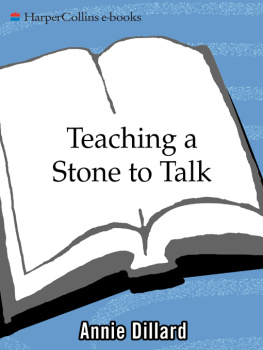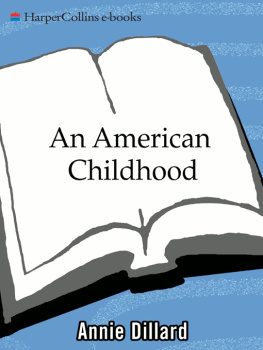ANNIE DILLARD

FOR THE TIME BEING
Annie Dillard is the author of ten other books, including The Living, a novel; An American Childhood, a memoir; and Teaching a Stone to Talk, a collection of essays The Boston Globe judged one of the best books of the 1980s.
ALSO BY ANNIE DILLARD
Mornings Like This
The Living
The Writing Life
An American Childhood
Encounters with Chinese Writers
Teaching a Stone to Talk
Living by Fiction
Holy the Firm
Pilgrim at Tinker Creek
Tickets for a Prayer Wheel
FOR LEE SMITH
The legend of the Traveler appears in every civilization, perpetually assuming new forms, afflictions, powers, and symbols. Through every age he walks in utter solitude toward penance and redemption.

Should I mark more than shining hours?

I have agreed to paint a narrative on the city walls.
I have now been at work many years,
there is so much to be told.
EVAN S. CONNELL, JR.
Notes from a Bottle Found on the Beach at Carmel
CHAPTER ONE
B I R T H  I have in my hands the standard manual of human birth defects. Smiths Recognizable Patterns of Human Malformation, fourth edition, by Kenneth Lyons Jones, M.D., professor of pediatrics at UC-San Diego, 1988, is a volume to which, in conscience, I cannot recommend your prolonged attention. In vivid photographs, it depicts many variations in our human array.
I have in my hands the standard manual of human birth defects. Smiths Recognizable Patterns of Human Malformation, fourth edition, by Kenneth Lyons Jones, M.D., professor of pediatrics at UC-San Diego, 1988, is a volume to which, in conscience, I cannot recommend your prolonged attention. In vivid photographs, it depicts many variations in our human array.
This photograph shows, for example, the bird-headed dwarfs. They are a brother and sister; they sit side by side on a bed. The boy a blond, is six years old, says the caption, and the girl, brown-haired, is three. Indeed their smooth bodies and clear faces make them look, at first and second glances, to be six and three years old. Both are naked. They have drawn their legs up to their chests. The camera looks down on them. The girl has a supercilious expression, and seems to be looking down her nose at the camera. Bright children often show this amused and haughty awareness: And who might you be, Bub?
The girls nose is large, her eyes are large, her forehead recedes a bit, and her jaw is small. Her limbs are thin but not scrawny. Her thoughtful big brother looks quite like her. His nose is big. His eyes are enormous. He gazes off to the side, as if wishing he were somewhere else, or reflecting that this camera session will be over soon. His blond hair, cut rather Frenchily in layers, looks ruffled from playing.
Friendly and pleasant, the text says of bird-headed dwarfs; they suffer moderate to severe mental deficiency. That is, the bird-headed dwarf girl whose face I read as showing amused and haughty awareness may, I hope, have been both aware and amused in her life, but she was likely neither haughty nor bright. The cerebrum of both the boy and the girl is faulty. The cerebrum shows a simple primitive convolutional pattern resembling that of a chimpanzee. They have only eleven pairs of ribs apiece; they cannot straighten their legs; like many bird-headed dwarfs, they have displaced hips. Others have displaced elbows. Easily distracted, the text says.
The stunning thing is the doctors hand, which you notice at third glance: It shows the children in scale. The doctors hand props the boy up by cupping his shouldersboth his shouldersfrom behind. The six-year-olds back, no longer than the doctors open hand, is only slightly wider than a deck of cards. The childrens faces are the length of the doctors thumb. These people have, as a lifelong symptom, severe short stature. The boy is the size of an eleven-month-old infant; the girl is the size of a four-month-old infant. If they live and grow, and get their hips fixed, they can expect to reach a height of about three feet. One bird-headed dwarf lived to be seventy-five years old, no taller than a yardstick.
And friendly and pleasant, but easily distracted. There is a lot to be said for children who are friendly and pleasant. And youare you easily distracted yourself, these days?
If your child were a bird-headed dwarf, mentally deficient, you could carry him everywhere. The bird-headed dwarfs and all the babies in Smiths manual have souls, and they all canand doreceive love and give love. If you gave birth to two bird-headed dwarfs, as these childrens mother dida boy and a girlyou could carry them both everywhere, all their lives, in your arms or in a basket, and they would never leave you, not even to go to college.
The Talmud specifies a certain blessing a man says when he sees a person deformed from birth. All the Talmudic blessings begin Blessed art Thou, O Lord, our God, King of the Universe, who The blessing for this occasion, upon seeing a hunchback or a midget or anyone else deformed from birth, is Blessed art Thou, O Lord, our God, King of the Universe, WHO CHANGES THE CREATURES.
A chromosome crosses or a segment snaps, in the egg or the sperm, and all sorts of people result. You cannot turn a page in Smiths Recognizable Patterns of Human Malformation without your hearts pounding from simple terror. You cannot brace yourself. Will this peculiar baby live? What do you hope? The writer calls the paragraph describing each defects effects, treatment, and prognosis Natural History. Here is a little girl about two years old. She is wearing a dress with a polka-dot collar. The two sides of her face do not meet normally. Her eyes are far apart, and under each one is a nostril. She has no nose at all, only a no-mans-land of featureless flesh and skin, an inch or two wide, that roughly bridges her faces halves. You pray that this grotesque-looking child is mentally deficient as well. But she is not. Normal intelligence, the text says.
Of some vividly disfigured infants and childrenof the girl who has long hair on her cheeks and almost no lower jaw, of the three-fingered boy whose lower eyelids look as if he is pulling them down to scare someone, of the girl who has a webbed neck and elbows, rocker-bottom feet, sad, fixed features, and no chinthe text says, Intelligence normal. Cosmetic surgery recommended.
Turn the page. What could cosmetic surgery do for these two little boys? Their enormous foreheads bulge like those of cartoon aliens; their noses are tiny and pinched, the size of rose thorns; and they lack brows, lashes, and chins. Normal intelligence.
Of God, the Kabbalah asserts: Out of that which is not, He made that which is. He carved great columns from the impalpable ether.
Here is one fine smiling infant. Why is a fine smiling infant pictured in this manual? You must read it. The infant does indeed present the glad sight of a newborn baby, but it will develop oddly. Note the tight fistthe expert in the manual points it out to the attending pediatricianand observe the tiny pit in the skin just before the ear, or the loose skin at the back of the neck. Observe the thin sparse hair, small nose, and subtly small fingernails. What baby, you cry, lacks these features?


















